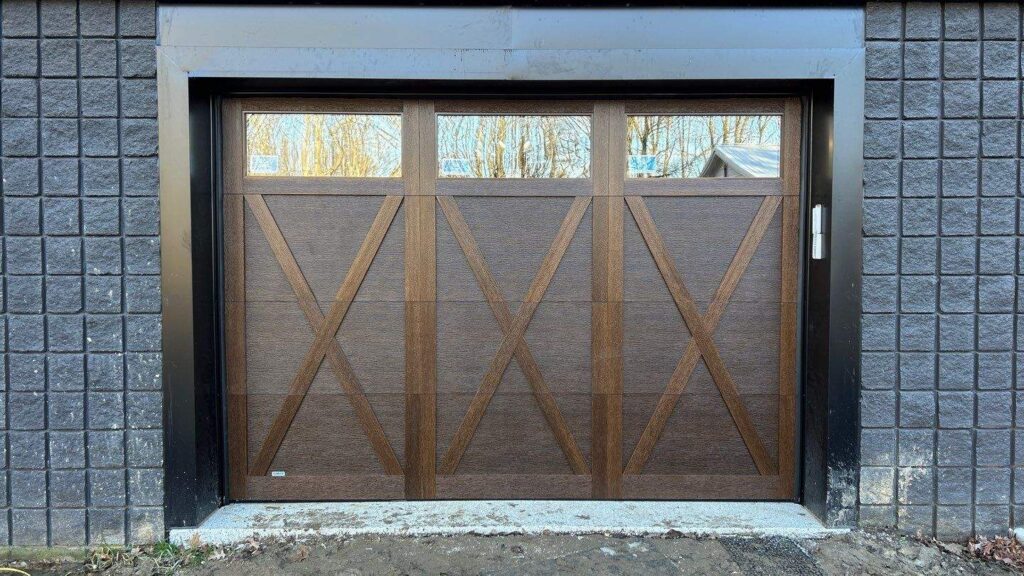
Innovative technology is transforming every part of the home, and garage doors are no exception. Homeowners in Southwestern Ontario – from Windsor to Chatham – are increasingly interested in garage opener installation upgrades that offer modern convenience and better security. For over 20 years, residents of Windsor, Essex, Chatham, and Kent counties have trusted Anchor Doors & Service for top-quality garage door installation and service. Drawing on this decades-long expertise, this guide explores how garage door technology has evolved, the rise of smart openers, and what these innovations mean for your home. Whether you’re curious about remote access, integration with Alexa or Google Home, or the safety of WiFi-enabled openers, read on for an expert overview tailored to our Southwestern Ontario community.
The Evolution of Garage Door Technology
Modern garage door openers have come a long way from the clunky machines of the past. Early garages in the mid-20th century relied on heavy wooden doors that had to be lifted manually. The first significant innovation was the overhead garage door and automatic opener, introduced in the 1920s and 1930s, which allowed doors to lift vertically and be operated by a motor. By the 1950s, remote-controlled garage door openers became available, using simple radio transmitters so homeowners could open the garage without leaving their cars. This was a game-changer in convenience – no more getting out in the rain or winter cold to open the door.
New challenges appeared as these remote openers grew popular through the 1960s and 70s. Early remotes often operated on fixed codes, meaning a neighbor’s remote could sometimes open your door if it shared the same frequency. In response, the industry improved security.
The 1970s saw the introduction of safety sensors that would stop and reverse a closing door if an object or person was in the way. This critical safety feature prevented injuries. By the 1980s and 90s, manufacturers added rolling code technology to remotes, generating a new code with each use to thwart code grabbers and would-be intruders. Garage door openers also started integrating with home security systems in the 1990s, reflecting homeowners’ growing demand for security and peace of mind.
The 2000s ushered in the era of smart garage door openers, bringing garage tech into the digital age. With the advent of Wi-Fi and smartphones, modern systems can now be monitored and controlled from anywhere via an app. Leading brands like LiftMaster (Chamberlain) introduced internet-connected features such as the MyQ® system, enabling real-time alerts, remote open/close commands, and integration with other smart home devices. In the last decade, innovations have accelerated further – openers commonly include Wi-Fi connectivity, battery backup systems, and even integration with voice assistants like Amazon Alexa and Google Assistant. Some of the newest models come with built-in cameras and advanced sensors; for example, LiftMaster’s latest openers can stream live video from your garage and send push notifications when the door is used, allowing secure in-garage package deliveries and peace of mind about who’s accessing your garage.
What was once a simple convenience device has evolved into a sophisticated smart home component. This evolution means today’s homeowners have many more features and options to consider when planning a garage door opener upgrade. In the following sections, we’ll discuss the key features and benefits of these smart garage door openers and how they integrate with broader home automation systems.
Smart Garage Door Openers: Key Features and Benefits
Smart garage door openers are packed with high-tech features that enhance convenience, security, and connectivity. Upgrading to a Wi-Fi–enabled opener can bring numerous benefits to your daily routine. Here are some of the key features and benefits to know about modern smart openers:
- Remote Control via Smartphone Apps: With a brilliant opener, you can open, close, and monitor your garage door from your smartphone or tablet. As long as your opener is connected to your home Wi-Fi, you have control from anywhere in the world. I forgot whether you closed the garage. Just check the app instead of driving back home. You can also receive real-time alerts – for instance, get notified if the garage door is left open or whenever it opens or closes. This level of access and awareness provides excellent peace of mind, especially when you’re away from home.
- Voice Assistant Integration: Many smart openers work with voice assistants and speakers like Amazon Alexa, Google Assistant, or Apple Siri/HomeKit. This means you can control your garage with simple voice commands. For example, you might say, “Alexa, close the garage door” when your hands are full, and the opener will obey (after confirming your secure PIN code). This hands-free convenience is more than a gimmick – it can be genuinely helpful when entering or exiting with groceries, equipment, or children in tow. Voice integration also allows you to incorporate the garage door into home automation routines – for instance, you could set up a routine to automatically close the garage at a particular time each night or open it when you say a specific phrase.
- Smart Home System Connectivity: Beyond voice control, smart garage openers can tie into broader home automation systems. They often integrate with platforms like Google Home, Amazon Alexa, Apple HomeKit, Samsung SmartThings, or EFT. This integration lets your garage door work in tandem with other smart devices. For example, you could have your bright lights turn on when the garage door opens at night or receive an alert on your security system if the door opens unexpectedly during set hours. Major garage opener manufacturers provide apps and cloud services (e.g., Chamberlain’s MyQ® or Genie’s Aladdin Connect®), which can be linked to other services. MyQ, for instance, works with popular platforms and even allows secure Amazon Prime in-garage deliveries through Amazon Key. The ability to integrate means your garage door becomes an active part of your smart home ecosystem, not an isolated device.
- Enhanced Security Features: Modern openers come with robust security measures. Rolling code technology (also called hopping codes) is standard, meaning the remote code changes with every use to prevent code theft. Moreover, Wi-Fi garage door openers use encryption protocols to secure the transmitted signals and data. In practice, a brilliant opener is tough for outsiders to hack or “clone.” You can also monitor the opener’s activity logs in the app to know exactly what time the door was opened or closed and by whom. Some advanced models even include an automatic garage door lock that engages when the door is closed, adding a physical deadbolt-like reinforcement. Overall, these features keep your home safer than ever – and often more secure than older openers, which could be vulnerable to stolen remote codes or lost clickers.
- Safety and Sensor Improvements: Just as past generations of openers added safety sensors, smart openers have taken safety up a notch. You still get the standard safety photo-eye sensors that stop the door if something (or someone) is underneath. In addition, innovative technology can alert you if the door encounters an obstruction or has been left open too long. Many units allow you to set a timer-to-close so the door will automatically close after a few minutes if you forget (e.g., 5 or 10 minutes). This helps prevent the garage from inadvertently staying open all night. With smartphone alerts and scheduled closing, you’re much less likely to leave the garage open accidentally.
- Geofencing and Automation: Some innovative garage systems offer geofencing, which uses your phone’s GPS location to trigger actions. For example, the opener’s app can detect when you’re approaching home and automatically open the garage door as you arrive (or, conversely, close it when you depart). This feature means you don’t have to pull out your phone or press a remote button – the system “just knows.” Geofencing can be especially handy for families: each member’s phone can be set up, so the door opens for you but not for unknown devices. It’s another layer of convenience that makes access seamless.
- Multiple Users and Remote Sharing: Smart openers allow garage access to others without handing them a physical key or remote. You can usually share digital access with family members or trusted people through the app. For instance, give your spouse and kids their logins or temporarily allow a neighbor or handyman to open the garage on a particular day. Digital keys can often be limited to specific times or revoked easily. This is far safer and more controllable than hiding a spare garage remote outside. You’ll also be able to see exactly when the door was opened and by whom, since each user can be identified in the system.
- Battery Backup and Reliability: Modern garage door openers often include a battery backup system because they are critical entry points. Suppose a power outage occurs (which is not uncommon during Ontario winter storms or summer thunderstorms). In that case, a backup battery ensures you can open and close your garage door a few times. This is a key feature for security and convenience – you won’t be locked out of your garage (or trapped inside) just because the power is down. A battery backup is a valuable safeguard in Southwestern Ontario’s climate, where high winds or ice can sometimes knock out power. Additionally, today’s openers still come with manual release cords, so you can always pull a cord to disengage the opener and operate the door by hand in an emergency.
- Advanced Extras: Depending on the model, you might find other impressive extras. LED lighting is now commonly built into openers, providing bright illumination in your garage with energy-efficient lights. Some premium openers include an integrated camera that activates on motion or when the door opens, letting you see a live video feed of your garage interior through the app. This is great for security and for confirming deliveries. Even models with two-way audio allow communication through the opener (useful if you’re letting someone in remotely and need to talk to them). Finally, the drive mechanisms have improved – belt-drive and direct-drive openers operate much more quietly than the old chain drives, a big plus if your garage is attached to a living space. In short, smart garage door openers combine multiple conveniences: they give you new ways to control access, strengthen security, and ensure safe operation, all while making the garage door system quieter and more reliable.
With these benefits in mind, it’s clear why so many homeowners are upgrading to smart openers. The next consideration is how these devices work with the rest of your smart home, especially popular voice assistants and automation platforms.
How to Connect Your Garage Door Opener to Alexa, Google Home & More
One of the biggest appeals of a brilliant garage opener is the ability to integrate it with voice assistants and smart home hubs you may already use. Being able to say, “Google, open the garage,” or have your Amazon Alexa app notify you if the garage door was left open can enhance your daily convenience. So, how do you connect your garage door opener to Alexa, Google Home, or other smart home systems?
Our guide, How to Connect Your Garage Door Opener to Alexa, Google Home & More, provides a step-by-step walkthrough for linking various opener brands to voice assistants. Here, we’ll summarize the basic process and considerations:
First, you’ll need a Wi-Fi-enabled garage door opener (or a smart retrofit device attached to an older opener) that supports external integrations. Many newer openers come with this capability built in. For example, Chamberlain/LiftMaster units use the MyQ® system, and Genie openers often use Aladdin Connect®. Each of these systems has its own smartphone app and cloud service. To connect them with Alexa or Google Assistant, you typically use the opener’s app to enable the integration (often called a “skill” in Alexa or linking an account in Google Home). For instance, with Genie’s Aladdin Connect, you would install the Aladdin Connect app, create an account, then enable the Genie skill in the Alexa app and sign in with your Genie account. Google Home integration is similar – you add the device through the Google Home app and sign in to link the accounts.
After linking, you can usually control the garage using a voice command after connecting. Amazon Alexa and Google Assistant will require a secure authentication step to unlock or open the garage door via voice. For security reasons, Alexa and Google require you to say or input a PIN code to open the garage door. (Depending on the system, closing the door might be allowed without a PIN since letting anyone close it is generally safer.) Once your PIN is set and the voice assistant discovers the device, you can use natural commands like “Alexa, open my garage door” or “Hey Google, is the garage door closed?” to interact with your opener.
Integration isn’t limited to Alexa and Google. If you use Apple HomeKit, some openers (or add-on bridges) support Siri voice commands and Home app control. There are also integrations with smart home hubs like SmartThings, Hubitat, or Home Assistant. For example, MyQ can be integrated with other systems to create automation routines, like flashing your Hue lights when the garage opens or logging events in a home management app. Services like IFTTT (If This Then That) can also link a brilliant garage opener to trigger or respond to other events (e.g., “If the garage door opens, then send me an SMS and turn on the porch light”). The possibilities depend on what your opener’s ecosystem supports.
When setting up these connections, ensure your garage’s Wi-Fi signal is strong enough for reliable communication (you might need a Wi-Fi extender if the signal is weak). Also, always use the official apps/skills provided by the manufacturer for integration, as they are designed to be secure. The exact pairing steps can vary by brand, which is why our dedicated “How to Connect” article breaks down the process for popular systems like MyQ and Aladdin Connect.
By following the guide and tips in that article, you’ll be able to get your garage door talking to Alexa, Google Home, and more in no time, bringing your garage fully into the voice-controlled smart home era.
Are WiFi-Enabled Garage Doors Safe? Myths vs. Facts
Whenever we introduce internet connectivity to something as important as a garage door, it’s natural for homeowners to have safety and security concerns. In our experience, many worries stem from misconceptions. Let’s address some common myths about WiFi-enabled garage door openers and the real facts behind them:
- Myth: “Smart garage door openers can be easily hacked.”
- Fact: Smart openers employ strong security measures, making them difficult to hack. These devices use advanced encryption and rolling codes for all wireless signals. While no internet-connected device is 100% hack-proof, the risk of someone remotely compromising your garage opener is extremely low. Security experts say the odds of a thief hacking into your Wi-Fi opener are far lower than the odds of a burglar simply breaking in through a window or door by force. Manufacturers are aware of potential cyber threats and continuously update their apps and firmware to patch vulnerabilities. In short, Wi-Fi garage door openers are among the safest smart home devices because they’re designed with security as a top priority.
- Myth: “If my opener relies on Wi-Fi, I won’t be able to open/close the garage if the internet or power goes out.”
- Fact: A Wi-Fi brilliant opener never replaces your traditional remotes or safety features – it augments them. Regardless of internet status, you can continuously operate the garage door with the standard RF remote fob or the interior wall button. And if the power goes out, virtually all modern openers have a manual release cord that lets you open the door by hand. Additionally, many smart openers include battery backups for power outage situations. The innovative features (like app control) require Wi-Fi and power. However, their loss won’t lock you out of your garage; they temporarily revert your opener to “traditional mode” until connectivity is restored. You aren’t worse off than a garage door opener during outages – you have the same fallbacks available.
- Myth: “Connecting my garage door to Alexa or Google Home is a security risk – someone could yell through a window to open it.”
- Fact: Voice assistant platforms have built-in safeguards to prevent unauthorized entry. As noted above, Alexa and Google Assistant require a user to provide a PIN or verification to execute a voice command to open a garage door. This means a random stranger shouting, “Alexa, open the garage!” outside your house won’t have any effect unless they know your secure PIN code. The systems are designed so that only an authorized user with the proper voice profile and PIN can trigger the door to open. You can also turn off voice open completely in the assistant settings and use the app notifications and alerts instead. As for the garage opener’s mobile app itself, it will be protected by your username/password and often multi-factor authentication. Of course, it’s essential to keep your account credentials secure, just as you would for online banking, but the platforms go to great lengths to ensure that convenience doesn’t come at the cost of security. Appropriately used, Wi-Fi-enabled garage doors are safe and arguably safer than older openers that lacked today’s encryption and authentication measures.
In summary, the facts show that smart garage door openers are designed with security in mind. They use encrypted signals, require authentication for critical commands, and have backups for power or network failures. Moreover, manufacturers constantly test and improve the software. (Many even hire third-party security firms to audit their devices and will release updates to address any vulnerabilities.) To stay safe, homeowners should follow good digital practices: use strong, unique passwords for the apps, keep the opener’s firmware/app updated to the latest version, and be mindful of who you share access with. If you do that, a Wi-Fi-connected opener can be a secure part of your smart home.
Garage Opener Installation: Tips for a Successful Upgrade

If you’re considering upgrading to a brilliant garage door opener, you’ll want the installation and setup to go smoothly. Based on Anchor Doors & Service’s long experience with garage opener installations, here are some essential tips and considerations for homeowners:
- Assess Your Current Door and Opener: Look at what you already have. Is your existing garage door in good condition and balanced? What type of opener do you have now (chain drive, belt drive, etc.), and is it still functioning well? If your opener is over 15-20 years old, it likely lacks modern safety features and may be due for replacement anyway. Ensure that your garage door moves freely and its springs and hardware are in good shape – a new opener might struggle if the door is heavy or binds. Also, verify your door’s compatibility with the new opener. Most standard sectional garage doors (common in homes across Southwestern Ontario) will work with any modern opener. However, if you have an unusual or one-piece flip-up door, check the opener specs for compatibility. Some smart openers are better suited for heavier or larger doors than others, so choose a model that fits your door’s size and weight.
- Choose the Features You Need: Smart openers have various features (as outlined earlier). Make a list of what matters to you. For example, is quiet operation a top priority (perhaps because there’s a bedroom above the garage)? Then, a belt drive or wall-mounted jackshaft opener might be best. Do you want an integrated battery backup for power outages? How about built-in Wi-Fi, or are you open to using a plug-in intelligent garage controller on a non-Wi-Fi opener? Decide if features like a camera, motion-activated lights, or the ability to control multiple garage doors from one unit are worth any extra cost. Knowing your must-haves will help narrow down the choices. It’s also wise to opt for a reputable brand with good support and security track record – LiftMaster/Chamberlain, Genie, Craftsman, and others have well-established bright opener lines (Anchor Doors & Service recommends LiftMaster for its reliability and advanced tech, based on decades of servicing all brands). A quality opener may cost a bit more upfront, but it will last longer and cause fewer headaches in the long run.
- Ensure a Strong Wi-Fi Signal in the Garage: Since you’re specifically interested in a brilliant opener, it will rely on Wi-Fi for many features. Before installation, test your home Wi-Fi reception in the garage (near where the opener will be mounted). If the signal is weak or inconsistent there, you might need to reposition your router or use a Wi-Fi range extender so that your garage can get a solid connection. A strong Wi-Fi signal is crucial for the opener’s app connectivity and remote functions. During setup, you’ll connect the opener to your Wi-Fi network via its app; having the network password handy and a sound signal will make this process smoother. Once connected, most openers will notify you via the app if they ever go offline, so you can troubleshoot as needed. Planning for connectivity will spare you frustration after the opener is installed.
- Think About Smart Integration Now (and Later): Consider how the garage opener will integrate if you have existing smart home devices (like Alexa or a security system). Choose an opener that is compatible with your preferred ecosystem. For example, if you’re an Alexa household and want voice control without extra hubs, look for models that support Alexa natively or via the manufacturer’s skill. If you use Apple HomeKit, ensure the opener is HomeKit-enabled (some Chamberlain/LiftMaster models require an additional bridge device for HomeKit). On the other hand, even if you’re not using any smart home platforms now, it’s wise to install the opener in a way that leaves room for future upgrades. Have the technician mount the opener’s Wi-Fi antenna (if external) in a good location and show you how to link accounts. You might not enable all integrations on day one, but you may add more smart devices you’ll want to sync with the garage. Installing a brilliant opener now effectively future-proofs your garage for whatever home automation tech comes next.
- Safety, Security, and Setup Tips: When the installation takes place, be sure the installer tests the safety reversal mechanism thoroughly – the door should reverse promptly when the sensor beam is broken or if it hits an object. You’ll also want to set up your user accounts securely. Use a strong password for the opener’s app and enable features like two-factor authentication if available. Take advantage of any smart alerts offered – for example, set the app to alert you if the door is open longer than 10 minutes or if it opens at an unusual time. Such alerts can prompt you to check on things or close the door remotely. After installation, educating your family members on how to use the new opener and app is a good idea. Show them how to operate it via a wall switch, remote, and smartphone, and explain any new behaviors (like the fact that the opener might beep and flash for a few seconds before closing when commanded via smartphone – a standard safety warning to anyone nearby). Finally, don’t forget to keep the opener’s software updated. The mobile app or the unit itself will occasionally prompt for firmware updates; these updates often include security improvements or new features, so it’s wise to install them. Treat your smart opener like any smart device – maintain it, update it, and it will serve you well.
- Professional vs. DIY Installation: A savvy DIYer with the right tools can install a garage door opener, but there are reasons many homeowners opt for professional installation. An expert will ensure the opener is mounted correctly and securely (preventing vibration or premature wear), adjust the travel limits and force settings properly, and sync up all remotes, keypads, and app features for you. They will also haul away your old unit and dispose of it. Most importantly, a professional installer knows how to do the job safely – garage doors and springs can be dangerous if you’re unfamiliar, as the door is heavy. The torsion spring is under high tension. Professionals also guarantee their work, so they’ll return and fix any issues that arise shortly after installation. Given a garage door’s weight and critical nature, having a certified technician from a trusted local company (like Anchor Doors & Service, which has certified industry professionals on staff) handle the installation can provide peace of mind. If you do choose DIY, be sure to follow the manufacturer’s instructions in the letter. Never remove or adjust the spring tension as part of an opener install, beyond the scope of the opener itself. And always get a second person to help when mounting the unit and hanging the door arm, for safety’s sake. In short, know your limits. There’s no shame in hiring a pro to ensure such vital equipment is set up correctly.
By following these tips – from planning the features you need to budget to ensuring proper setup – you can make your garage door opener upgrade a smooth experience. The result will be a high-tech garage entry that adds convenience and value to your home.
Embracing the Future of Garage Doors in Southwestern Ontario
The garage door may be one of the last parts of the home you’d expect to join the innovative technology revolution, but as we’ve seen, smart garage door openers are here and rapidly becoming the norm. For homeowners in Southwestern Ontario and beyond, these innovations offer an opportunity to enhance daily life, providing convenience (no more worrying if you left the door open), improved security and safety features, and seamless integration with the growing array of home automation devices. The future of garage doors is all about connectivity and control at your fingertips (or the sound of your voice), and that future is available today.
As a long-time local expert, Anchor Doors & Service has witnessed this evolution firsthand – from the days of simple flip-switch openers to the advanced Wi-Fi-enabled systems now on the market. With over two decades of experience serving Windsor, Essex, Chatham, Kent, and the surrounding areas, Anchor Doors & Service is committed to keeping homeowners informed about the latest garage door technology and providing professional, trustworthy installation when you’re ready to upgrade.
We hope this comprehensive guide has answered your questions about smart garage door openers and how they fit into your home. Remember, upgrading your garage opener is not just about getting a new gadget – it’s about enhancing the security and functionality of one of the primary entry points to your house. When done right, a garage opener installation can deliver years of smooth, reliable service and adapt to your lifestyle, from daily commutes to family vacations and everything in between.
If you’re considering taking the next step toward a smarter garage, don’t hesitate to reach out to a trusted professional for advice. The Anchor Doors & Service team is always here to help with honest assessments, quality products, and expert installation. The future of garage doors is bright, convenient, and secure – and it’s available now to Southwestern Ontario homeowners who want to embrace it. By upgrading to a brilliant opener and integrating it with your home, you’ll be opening the door (quite literally) to new possibilities in home convenience and security for years to come.
By staying informed and working with experienced professionals, you can confidently upgrade to a brilliant garage door opener and enjoy all the benefits of a more connected, automated home. Here’s to the future of garage doors and the added convenience and security they bring to our homes in Windsor-Essex and Chatham-Kent!

















